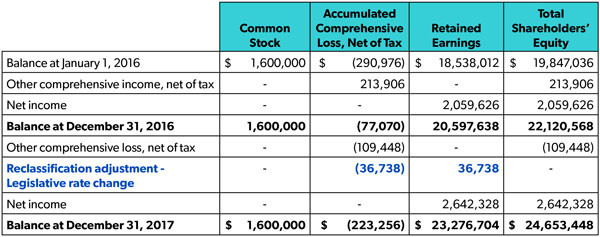February 15, 2018
Stranded Tax in AOCI: Relief has Arrived
On February 14, 2018, FASB issued ASU 2018-02, Reclassification of Certain Tax Effects from Accumulated Other Comprehensive Income. This standard gives companies the option to reclassify the “stranded” tax out of accumulated other comprehensive income (AOCI) to retained earnings as a result of the Tax Cuts and Jobs Act of 2017 (the Act), which is a welcome relief.
Background
On December 22, 2017, the Act was signed into law. Among other things, the Act reduced the corporate federal tax rate to a flat 21%. As a result, companies need to re-measure deferred tax assets and liabilities at the new 21% tax rate. GAAP requires the effect of a change in tax laws or rates be included in income from continuing operations in the period of the enactment date. As such, calendar year-end entities need to re-measure their deferred items within their December 31, 2017 financial statements and record the change in deferred tax resulting from the rate change in the “Federal Income Tax” line in the income statement. This treatment applies even for the deferred balances related to items originally recorded through AOCI. This new guidance allows companies to reverse the effect of the “stranded” tax in AOCI created by the Act and resets the balance in AOCI at the new tax rate.
Illustration
The following example illustrates the financial statement presentation of the reclassification of the “stranded” tax.

The amount of the reclassification should include the following: (1) the effect of the change in the U.S. federal corporate income tax rate on the gross deferred tax amounts and related valuation allowances, if any, at the date of enactment of the Act related to items remaining in AOCI, and (2) other income tax effects of the Act for items remaining in AOCI, that an entity elects to reclassify.
Disclosures
A company electing to reclassify the income tax effects of the Act will be required to disclose the following in the period of adoption:
- A description of the accounting policy for releasing the income tax effects from AOCI
- A statement that an election was made to reclassify the income tax effects of the Act from AOCI to retained earnings
- A description of other income tax effects related to the application of the Act that are reclassified from AOCI to retained earnings
If a company does not elect to reclassify, they must disclose that an election was not made to reclassify the income tax effects of the Act from AOCI to retained earnings.
Effective date
The guidance is effective for fiscal years beginning after December 15, 2018, and interim periods within those fiscal years. Early adoption is permitted for entities that have not yet issued their financial statements. A company has the option to apply the amendments in the reporting period of adoption or retrospectively to each period(s) in which the effect of the change in federal income tax rate in the Act is recognized. If retrospective application is chosen, a company would generally make a reclassification adjustment in the period of enactment and any subsequent period when changes to provisional amounts recorded under the SEC Staff Accounting Bulletin 118 result in additional amounts stranded in AOCI.


